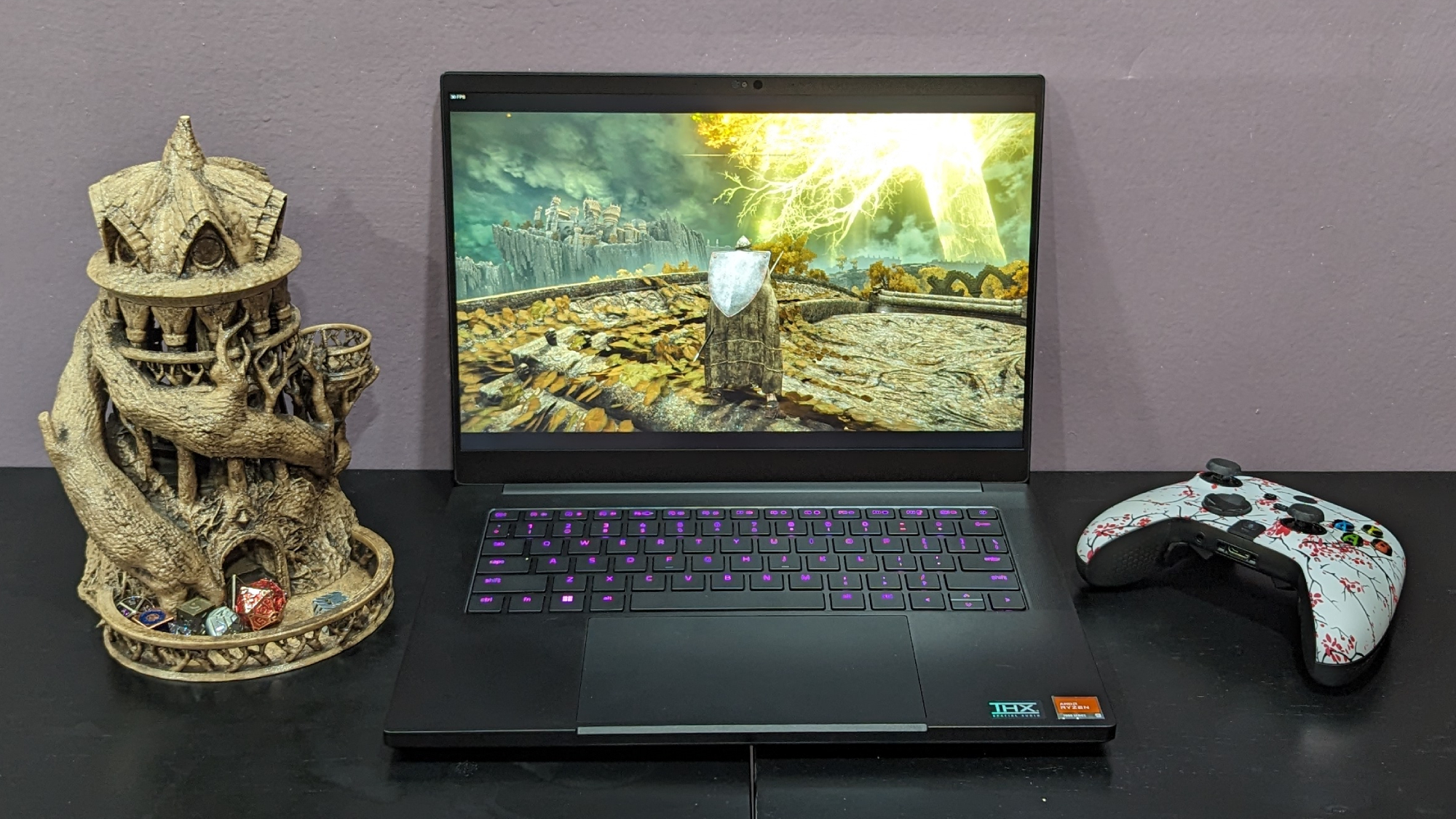After a week with the new Razer Blade 14, here's the gaming laptop I would buy instead
Razer's new hotness isn't worth the price tag

The Razer Blade 14 (early 2024) is a powerful, versatile gaming laptop. It's also incredibly portable, weighing just over 4 pounds. But despite that, if you're in the market for a new gaming laptop and you want a 14-inch Razer machine, we'd still have to recommend the Blade 14 (mid-2023) model.
There are only a handful of differences between the two laptops, as they're built on the same chassis, feature the same Nvidia GeForce RTX 4070 GPU, have the same spec display, and have similar memory and storage configuration options. In fact, the AMD Ryzen 9 processor is the only major change between the generations. The 2023 Blade 14 features a Ryzen 9 7940HS processor, while the 2024 Blade features a Ryzen 9 8945HS processor.
Razer is still selling the Blade 14 (mid-2023) model, and the 2022 model, for that matter. But with nearly identical specs to the 2024 model, the 2023 Blade 14 is a few hundred dollars cheaper for similarly powerful performance, a more vivid display, and better battery life.
So, with the 8th generation AMD chipset, you'd be trading off a slight increase in performance for far better battery life. So, how much of a difference is it?
Gaming performance
The gaming and general performance difference between the two Blade 14 models is almost negligible.
On the Direct X 12 4K gaming benchmark 3DMark Fire Strike Extreme, the Blade 14 (early 2024) scored an average of 7,307, while the Blade 14 (mid 2023) scored an average of 6,792. Roughly 500 points in 3DMark will hardly break your ability to game and primarily reflects the difference in memory between the two units. The Blade 14 (early 2024) unit we tested had 32GB of DDR5 RAM, while the Blade 14 (mid 2023) model featured only 16GB of memory.
| 3DMark Benchmark | Razer Blade 14 (Early 2024) | Razer Blade 14 (Mid 2023) |
|---|---|---|
| Fire Strike | 27,768 | 26,465 |
| Time Spy | 12,602 | 11,038 |
| Fire Strike Ultra | 7,307 | 6,792 |
| Port Royal (Ray Tracing) | 7,596 | 7,005 |
That difference was even more minor when we took more real-world gaming tests into account. On the Far Cry 6 benchmark at 1080p and Ultra High settings, the Blade 14 (early 2024) maintained an average frame rate of 86 frames-per-second (FPS), while the Blade 14 (mid 2023) had an average of 87 FPS. On Far Cry 6 at a QHD+ (2,560 x 1,600) resolution, the Blade 14 (early 2024) had a slight lead with 71 FPS compared to the Blade 14 (mid 2023)'s 68 FPS.
Get The Snapshot, our free newsletter on the future of computing
Sign up to receive The Snapshot, a free special dispatch from Laptop Mag, in your inbox.
On the Red Dead Redemption II benchmark at 1080p and Medium settings, the Blade 14 (early 2024) averaged 72.98 FPS, while the Blade 14 (mid 2023) averaged 73.43 FPS. At the native QHD+ resolution for both laptops, that gap remained small, with the Blade 14 (early 2024) averaging 45.58 FPS compared to the Blade 14 (mid 2023)'s 44.54 FPS.
| Gaming benchmark | Resolution | Razer Blade 14 (Early 2024) | Razer Blade 14 (Mid 2023) |
|---|---|---|---|
| Far Cry 6 | 1080p | 86 | 87 |
| Row 1 - Cell 0 | Native | 71 | 68 |
| Red Dead Redemption 2 | 1080p | 72.9823 | 73.4398 |
| Row 3 - Cell 0 | Native | 43.5851 | 44.5455 |
A handful of points in 3DMark and a gap of 1-3 FPS in gaming benchmarks is negligible. Especially with the Blade 14 (early 2024) having twice the amount of memory compared to the Blade 14 (mid 2023) model.
General performance
Regarding general performance, both laptops can handle general web surfing, email management, and even most design tasks easily, so the comparison comes down to the benchmarks. Regarding Geekbench 6 scores, the two Blade 14 laptops were nearly identical in single-core performance. The Blade 14 (early 2024) had a single-core average of 2,684 compared to the Blade 14 (mid-2023)'s 2,671 average. The Blade 14 (early 2024) had a multicore average of 13,781, which is a solid lead over the Blade 14 (mid 2023)'s 11,881 average. That said, 2,000 points of Geekbench 6 multicore performance is far from life-changing when you're already over the 10,000-point threshold.
The Blade 14 (early 2024) continued to have a slight lead over the 2023 Blade on our Handbrake and File Transfer Test benchmarks. The Blade 14 (early 2024) took 4 minutes and 1 second to export the 4K version of Tears of Steel as a 1080p 30 FPS format video, which is 44 seconds faster than the Blade 14 (mid-2023), which took 4:45 minutes to complete the same video encoding task.
On our File Transfer Test benchmark, which times how long the laptop takes to copy a 25GB multimedia folder, the Blade 14 (early 2023) had a much quicker transfer rate of 1,952 Mbps compared to the Blade 14 (mid-2023)'s 1,230 Mbps transfer rate.
| Laptop | Geekbench 6 single-core | Geekbench 6 multicore | Handbrake time | 25GB file copy time | Transfer rate (MBps) |
|---|---|---|---|---|---|
| Razer Blade 14 (Early 2024) | 2,684 | 13,781 | 04:01 | 13.8 | 1,952 |
| Razer Blade 14 (Mid 2023) | 2,671 | 11,881 | 04:45 | 21.8 | 1,230 |
So, the Blade 14 (early 2024) has a better lead in general performance, though the two laptops are nearly identically powerful at gaming. As previously stated, these small differences in general CPU performance are noteworthy but hardly life-changing for most gamers.
Battery life
Battery life is one thing that gaming laptops are traditionally very bad at. So, the fact that the Blade 14 (mid-2023) had over 8 hours of web surfing battery life was one of its major selling points for us.
The Laptop Mag battery test sets a laptop to 150 nits and cycles through a series of multimedia, static, and video web pages until the battery is fully drained. The Blade 14 (early 2024) managed a respectable 6 hours and 26 minutes on that benchmark, but it was well below the 8:34 offered by the Blade 14 (mid-2023).
Things were a bit better on the PCMark 10 Gaming battery life test, with both laptops set at 150 nits. The Blade 14 (early 2024) managed to last 1 hour and 52 minutes on that benchmark, while the Blade 14 (mid-2023) lasted 1:46. However, 8 minutes of gaming time on the PCMark 10 battery benchmark is not outside the realm of standard deviation.
| Laptop | Battery life (web surfing hh:mm) | Battery life (Gaming PCMark 10 hh:mm) |
|---|---|---|
| Razer Blade 14 (Early 2024) | 06:26 | 1:52 |
| Razer Blade 14 (Mid 2023) | 08:34 | 1:46 |
So, if the gaming battery tests are close enough, we would consider that parity between the generations, the Blade 14 (mid-2023) is clearly the superior choice for battery life. After all, that 2-hour gap in web surfing battery life is nothing to overlook. It's the difference between having a gaming laptop that can keep up with your day-to-day work for a full day and a laptop that only lasts for half the day.

Display
If the combination of similar performance between the two, longer battery life for the older model, and a much cheaper starting price weren't enough, let me tell you about the displays.
The Razer Blade 14 (mid-2023) display blew our reviewer away as she explored Elden Ring and found herself "temporarily lost in the deep black and golden glow of magic spells being tossed at me within Laskyar Ruins." Don't worry; we've got the numbers to back that up.
| Laptop | Display average brightness (nits) | DCI-P3 color gamut (%) | Delta-E color accuracy (smaller number is better) |
|---|---|---|---|
| Razer Blade 14 (Early 2024) | 446 | 78.90% | 0.23 |
| Razer Blade 14 (Mid 2023) | 464 | 114.30% | 0.07 |
The mid-2024 Razer Blade 14 beat the early 2024 model in all of our display benchmarks. Display brightness was admittedly close at 464 nits for the older model and 446 nits for the new one, both excellent scores. But the 2023 Blade 14 takes it to another level, covering 114.3% of the DCI-P3 color gamut compared to a mediocre 78.9% for the 2024 model. Delta-E color accuracy is only critical if you create content on the Blade 14, but if you are, the 2023 wins again with an astounding 0.07 compared to 0.23 for the 2024 model.
Verdict
As someone who loves to get as much performance power as I can out of a computer, it hurts to type these words regardless of how true they are. But when you have performance benchmarks as close as the Blade 14 (early 2024), and the Blade 14 (mid-2023), the 2,000 points of Geekbench 6 multicore performance isn't enough to compensate for the 2-hour disparity in battery life or the vastly better display.
So, it really does make more sense to pick the 2023 Blade 14. Especially when you consider that the older model Blade is also cheaper, starting at $1,899 compared to the 2024's $2,199 entry price.

A former lab gremlin for Tom's Guide, Laptop Mag, Tom's Hardware, and TechRadar; Madeline has escaped the labs to join Laptop Mag as a Staff Writer. With over a decade of experience writing about tech and gaming, she may actually know a thing or two. Sometimes. When she isn't writing about the latest laptops and AI software, Madeline likes to throw herself into the ocean as a PADI scuba diving instructor and underwater photography enthusiast.
